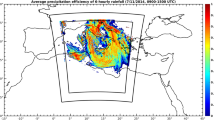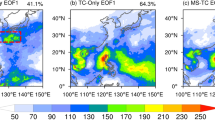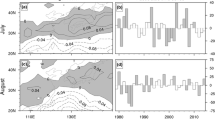Abstract
In this study, we provide an insight to the role of deep convection (DC) and the warm conveyor belt (WCB) as leading processes to Mediterranean cyclones’ heavy rainfall. To this end, we use reanalysis data, lighting and satellite observations to quantify the relative contribution of DC and the WCB to cyclone rainfall, as well as to analyse the spatial and temporal variability of these processes with respect to the cyclone centre and life cycle. Results for the period 2005–2015 show that the relationship between cyclone rainfall and intensity has high variability and demonstrate that even intense cyclones may produce low rainfall amounts. However, when considering rainfall averages for cyclone intensity bins, a linear relationship was found. We focus on the 500 most intense tracked cyclones (responsible for about 40–50% of the total 11-year Mediterranean rainfall) and distinguish between the ones producing high and low rainfall amounts. DC and the WCB are found to be the main cause of rainfall for the former (producing up to 70% of cyclone rainfall), while, for the latter, DC and the WCB play a secondary role (producing up to 50% of rainfall). Further analysis showed that rainfall due to DC tends to occur close to the cyclones’ centre and to their eastern sides, while the WCBs tend to produce rainfall towards the northeast. In fact, about 30% of rainfall produced by DC overlaps with rainfall produced by WCBs but this represents only about 8% of rainfall produced by WCBs. This suggests that a considerable percentage of DC is associated with embedded convection in WCBs. Finally, DC was found to be able to produce higher rain rates than WCBs, exceeding 50 mm in 3-h accumulated rainfall compared to a maximum of the order of 40 mm for WCBs. Our results demonstrate in a climatological framework the relationship between cyclone intensity and processes that lead to heavy rainfall, one of the most prominent environmental risks in the Mediterranean. Therefore, we set perspectives for a deeper analysis of the favourable atmospheric conditions that yield high impact weather.








Similar content being viewed by others
References
Alhammoud B, Claud C, Funatsu, BM, Béranger K, Chaboureau JP (2014) Patterns of precipitation and convection occurrence over the Mediterranean basin derived from a decade of microwave satellite observations. Atmosphere 5:370–398
Avila EE, Bürgesser RE, Castellano NE, Collier AB, Compagnucci RH, Hughes AR (2010) Correlations between deep convection and lightning activity on a global scale. J Atmos Sol-Terr Phys 72(14):1114–1121
Barrett AI, Gray SL, Kirshbaum DJ, Roberts NM, Schultz DM, Fairman JG (2015) Synoptic versus orographic control on stationary convective banding. Q J R Meteorol Soc 141:1101–1113. doi:10.1002/qj.2409
Belo-Pereira M, Dutra E, Viterbo P (2011) Evaluation of global precipitation data sets over the Iberian Peninsula. J Geophys Res Atmos 116:D20101. doi:10.1029/2010JD015481
Čampa J, Wernli H (2012) A PV perspective on the vertical structure of mature midlatitude cyclones in the northern hemisphere. J Atmos Sci 69:725–740. doi:10.1175/JAS-D-11-050.1
Campins J, Jansà A, Genovés A (2006) Three-dimensional structure of western Mediterranean cyclones. Int J Climatol 26:323–343. doi:10.1002/joc.1275
Cannon DJ, Kirshbaum DJ, Gray SL (2012) Under what conditions does embedded convection enhance orographic precipitation? Q J R Meteorol Soc 138:391–406. doi:10.1002/qj.926
Catto JL, Shaffrey LC, Hodges KI (2010) Can climate models capture the structure of extratropical cyclones? J Clim 23:1621–1635. doi:10.1175/2009JCLI3318.1
Chaboureau JP, Pantillon F, Lambert D, Richard E, Claud C (2012) Tropical transition of a Mediterranean storm by jet crossing. Q J R Meteorol Soc 138(664):596–611
Claud C, Alhammoud B, Funatsu BM, Chaboureau JP (2010) Mediterranean hurricanes: large-scale environment and convective and precipitating areas from satellite microwave observations. Nat Hazard Earth Syst Sci 10:2199–2213. doi:10.5194/nhess-10-2199-2010
Claud C, Alhammoud B, Funatsu BM, Lebeaupin Brossier C, Chaboureau JP, Béranger K, Drobinski P (2012) A high resolution climatology of precipitation and deep convection over the Mediterranean region from operational satellite microwave data: development and application to the evaluation of model uncertainties. Nat Hazards Earth Syst Sci 12:785–798. doi:10.5194/nhess-12-785-2012
Davolio S, Miglietta MM, Moscatello A, Pacifico F, Buzzi A, Rotunno R (2009) Numerical forecast and analysis of a tropical-like cyclone in the Ionian Sea. Nat Hazards Earth Syst Sci 9(2):551–562
Dee DP, Uppala SM, Simmons AJ, Berrisford P, Poli P, Kobayashi S, Andrae U, Balmaseda MA, Balsamo G, Bauer P, Bechtold P, Beljaars ACM, van de Berg L, Bidlot J, Bormann N, Delsol C, Dragani R, Fuentes M, GeerAJ, Haimberger L, Healy SB, Hersbach H, Holm EV, Isaksen L, Kallberg P, Köhler M, Matricardi M, McNally AP, Monge-Sanz BM, Morcrette JJ, Park BK, Peubey C, de Rosnay P, Tavolato C, Thépaut JN, Vitart F (2011) The ERA-interim reanalysis: configuration and performance of the data assimilation system. Q J R Meteorol Soc 137(656):553–597. doi:10.1002/qj.828
Dubois C, Somot S, Calmanti S, Carillo A, Déqué M, Dell’Aquilla A, Elizalde A, Gualdi S, Jacob D, L’hévéder B, Li L (2012) Future projections of the surface heat and water budgets of the Mediterranean Sea in an ensemble of coupled atmosphere–ocean regional climate models. Clim Dyn 39(7–8):1859–1884
Fita L, Romero R, Ramis C (2006) Intercomparison of intense cyclogenesis events over the Mediterranean basin based on baroclinic and diabatic influences. Adv Geosci 7:333–342
Fita L, Romero R, Luque A, Emanuel K, Ramis C (2007) Analysis of the environments of seven Mediterranean tropical-like storms using an axisymmetric, nonhydrostatic, cloud resolving model. Nat Hazards Earth Syst Sci 7:41–56. doi:10.5194/nhess-7-41-2007
Flaounas E, Kotroni V, Lagouvardos K, Flaounas I (2014) CycloTRACK (v1.0)—tracking winter extratropical cyclones based on relative vorticity: sensitivity to data filtering and other relevant parameters. Geosci Model Dev 7:1841–1853. doi:10.5194/gmd-7-1841-2014
Flaounas E, Raveh-Rubin S, Wernli H, Drobinski P, Bastin S (2015) The dynamical structure of intense Mediterranean cyclones. Clim Dyn 44(9–10):2411–2427
Flaounas E, Di Luca A, Drobinski P, Mailler S, Arsouze T, Bastin S, Beranger K, Lebeaupin Brossier C (2016a) Cyclone contribution to the Mediterranean Sea water budget. Clim Dyn 46(3–4):913–927
Flaounas E, Lagouvardos K, Kotroni V, Claud C, Delanoë J, Flamant C, Madonna E, Wernli H (2016b) Processes leading to heavy precipitation associated with two Mediterranean cyclones observed during the HyMeX SOP1. Q J R Meteorol Soc 142:275–286. doi:10.1002/qj.2618
Flaounas E, Kelemen FD, Wernli H, Gaertner MA, Reale M, Sanchez-Gomez E, Lionello P, Calmanti S, Podrascanin Z, Somot S, Akhtar N, Romera R, Conte D (2017) Assessment of an ensemble of ocean–atmosphere coupled and uncoupled regional climate models to reproduce the climatology of Mediterranean cyclones. Clim Dyn. doi:10.1007/s00382-016-3398-7
Funatsu BM, Claud C, Chaboureau JP (2007) Potential of advanced microwave sounding unit to identify precipitating systems and associated upper-level features in the Mediterranean region: case studies. J Geophys Res 112:D17113. doi:10.1029/2006JD008297
Galanaki E, Flaounas E, Kotroni V, Lagouvardos K, Argiriou A (2016) Lightning activity in the Mediterranean: quantification of cyclones contribution and relation to their intensity. Atmos Sci Lett. doi:10.1002/asl.685
Grams CM, Wernli H, Böttcher M, Čampa J, Corsmeier U, Jones SC, Keller JH, Lenz CJ, Wiegand L (2011) The key role of diabatic processes in modifying the upper-tropospheric wave guide: a North Atlantic case-study. Q J R Meteorol Soc 137:2174–2193. doi:10.1002/qj.891
Hawcroft MK, Shaffrey LC, Hodges KI, Dacre HF (2012) How much Northern Hemisphere precipitation is associated with extratropical cyclones? Geophys Res Lett 39:L24809. doi:10.1029/2012GL053866
Homar V, Jansà A, Campins J, Genovés A, Ramis C (2007) Towards a systematic climatology of sensitivities of Mediterranean high impact weather: a contribution based on intense cyclones. Nat Hazards Earth Syst Sci 7(4):445–454
Hong G, Heygster G, Miao J, Kunzi K (2005) Detection of tropical deep convective clouds from AMSU-B water vapor channels measurements. J Geophys Res Atmos 110:D5
Houze RA (2004) Mesoscale convective systems. Rev Geophys 42:RG4003. doi:10.1029/2004RG000150
Huffman GJ, Bolvin DT, Nelkin EJ, Wolff DB, Adler RF, Gu G, Hong Y, Bowman KP, Stocker EF (2007) The TRMM multisatellite precipitation analysis (TMPA): quasi-global, multiyear, combined-sensor precipitation estimates at fine scales. J Hydrometeorol 8:38–55. doi:10.1175/JHM560.1
Jansa A, Genoves A, Picornell M, Campins J, Riosalido R, Carretero O (2001) Western Mediterranean cyclones and heavy rain. Part 2: Statistical approach. Meteorol Appl 8(1):43–56. doi:10.1017/S1350482701001049
Katsanos D, Lagouvardos K, Kotroni V, Huffmann GJ (2004) Statistical evaluation of MPA-RT high-resolution precipitation estimates from satellite platforms over the central and eastern Mediterranean. Geophys Res Lett 31:L06116. doi:10.1029/2003GL019142
Kotroni V, Lagouvardos K (2008) Lightning occurrence in relation with elevation, terrain slope and vegetation cover over the Mediterranean. J Geophys Res 113:D21118. doi:10.1029/2008JD010605
Kotroni V, Lagouvardos K (2016) Lightning in the Mediterranean and its relation with sea-surface temperature. Environ Res Lett 11:034006
Kotroni V, Lagouvardos K, Kallos G, Ziakopoulos D (1999) Severe flooding over central and southern Greece associated with pre-cold frontal orographic lifting. Q J R Meteorol Soc 125:967–991
Lagouvardos K, Kotroni V (2007) TRMM and lightning observations of a low-pressure system over the Eastern Mediterranean. Bull Am Meteorol Soc 88(9):1363
Lagouvardos K, Kotroni V, Dobricic S, Nickovic S, Kallos G (1996) The storm of October 21–22, 1994, over Greece: observations and model results. J Geophys Res 101(D21):26217–26226. doi:10.1029/96JD01385
Lagouvardos K, Kotroni V, Defer E (2007) The 21–22 January 2004 explosive cyclogenesis over the Aegean Sea: observations and model analysis. Q J R Meteorol Soc 133(627):1519–1531
Lagouvardos K, Kotroni V, Betz HD, Schmidt K (2009) A comparison of lightning data provided by ZEUS and LINET networks over Western Europe. Nat Hazards Earth Syst Sci 9:1713–1717
Lionello P, Bhend J, Buzzi A, Della-Marta PM, Krichak SO, Jansà A, Maheras P, Sanna A, Trigo IF, Trigo R (2006) Chap. 6 Cyclones in the Mediterranean region: climatology and effects on the environment. In: Lionello P, Malanotte-Rizzoli P, Boscolo R (eds), Developments in earth and environmental sciences, vol 4. Elsevier, Amsterdam, pp 325–372
Lionello P, Trigo I, Gil V, Liberato M, Nissen K, Pinto J, Raible C, Reale M, Tanzarella A, Trigo R, Ulbrich S, Ulbrich U (2016) Objective climatology of cyclones in the Mediterranean region: a consensus view among methods with different system identification and tracking criteria. Tellus A 68:29391. doi:10.3402/tellusa.v68.29391
Llasat-Botija M, Llasat MC, López L (2007) Natural hazards and the press in the western Mediterranean region. Adv Geosci 12:81–85
Madonna E, Wernli H, Joos H, Martius O (2014) Warm conveyor belts in the ERA-Interim dataset (1979–2010). Part I: climatology and potential vorticity evolution. J Clim 27(1):3–26. doi:10.1175/JCLI-D-12-00720.1
Martínez-Alvarado O, Gray SL, Catto JL, Clark PA (2012) Sting jets in intense winter North-Atlantic windstorms. Environ Res Lett 7:024014
Martínez-Alvarado O, Joos H, Chagnon J, Boettcher M, Gray SL, Plant RS, Methven J, Wernli H (2014) The dichotomous structure of the warm conveyor belt. Q J R Meteorol Soc 140:1809–1824
McTaggart-Cowan R, Galarneau TJ Jr, Bosart LF, Milbrandt JA (2010) Development and tropical transition of an alpine lee cyclone. Part I: case analysis and evaluation of numerical guidance. Mon Weather Rev 138:2281–2307. doi:10.1175/2009MWR3147.1
Merrill RT (1988) Characteristics of the upper-tropospheric environmental flow around hurricanes. J Atmos Sci 45:1665–1677. doi:10.1175/1520-0469(1988)045>2.0.CO;2
Miglietta MM, Moscatello A, Conte D, Mannarini G, Lacorata G, Rotunno R (2011) Numerical analysis of a Mediterranean ‘hurricane’ over south-eastern Italy: sensitivity experiments to sea surface temperature. Atmos Res 101(1):412–426
Miglietta MM, Laviola S, Malvaldi A, Conte D, Levizzani V, Price C (2013) Analysis of tropical-like cyclones over the Mediterranean Sea through a combined modeling and satellite approach. Geophys Res Lett 40(10):2400–2405
Moscatello A, Miglietta MM, Rotunno R (2008) Observational analysis of a Mediterranean “hurricane” over southeastern Italy. Weather 63:306–311
Nissen KM, Leckebusch GC, Pinto JG, Renggli D, Ulbrich S, Ulbrich U (2010) Cyclones causing wind storms in the Mediterranean: characteristics, trends and links to large-scale patterns. Nat Hazards Earth Syst Sci 10(7):1379–1391
Papritz L, Pfahl S, Rudeva I, Simmonds I, Sodemann H, Wernli H (2014) The role of extratropical cyclones and fronts for southern ocean freshwater fluxes. J Clim 27:6205–6224. doi:10.1175/JCLI-D-13-00409.1
Pfahl S, Sprenger M (2016) On the relationship between extratropical cyclone precipitation and intensity. Geophys Res Lett 43:1752–1758. doi:10.1002/2016GL068018
Pfahl S, Wernli H (2012) Quantifying the relevance of cyclones for precipitation extremes. J Clim 25:6770–6780. doi:10.1175/JCLI-D-11-00705.1
Pfahl S, Madonna E, Boettcher M, Joos H, Wernli H (2014) Warm conveyor belts in the ERA-Interim dataset (1979–2010). Part II: moisture origin and relevance for precipitation. J Clim 27(1):27–40
Pinto J, Ulbrich S, Economou T, Stephenson D, Karremann M, Shaffrey L (2016) Robustness of serial clustering of extratropical cyclones to the choice of tracking method. Tellus A 68:32204. doi:10.3402/tellusa.v68.32204
Rasp S, Selz T, Craig GC (2016) Convective and slantwise trajectory ascent in convection-permitting simulations of midlatitude cyclones. Mon Weather Rev 144:3961–3975
Raveh-Rubin S, Wernli H (2015) Large-scale wind and precipitation extremes in the Mediterranean: a climatological analysis for 1979–2012. Q J R Meteorol Soc 141(691):2404–2417
Raveh-Rubin S, Wernli H (2016) Large-scale wind and precipitation extremes in the Mediterranean: dynamical aspects of five selected cyclone events. Q J R Meteorol Soc 142:3097–3114. doi:10.1002/qj.2891
Romero R (2001) Sensitivity of a heavy-rain-producing western Mediterranean cyclone to embedded potential-vorticity anomalies. Q J R Meteorol Soc 127(578):2559–2597
Romilly TG, Gebremichael M (2011) Evaluation of satellite rainfall estimates over Ethiopian river basins. Hydrol Earth Syst Sci 15(5):1505
Rudeva I, Gulev SK, Simmonds I, Tilinina N (2014) The sensitivity of characteristics of cyclone activity to identification procedures in tracking algorithms. Tellus A 66:24961. doi:10.3402/tellusa.v66.24961
Rysman JF, Claud C, Chaboureau JP, Delanoë J, Funatsu BM (2015) Severe convection in the Mediterranean from microwave observations and a convection-permitting model. Q J R Meteorol Soc 142:43–55. doi:10.1002/qj.2611
Rysman JF, Claud C, Delanoë J (2017) Monitoring deep convection and convective overshooting from 60°S to 60°N using MHS: a cloudsat/CALIPSO-based assessment. IEEE Geosci Remote S 14(2):159–163
Sprenger M, Wernli H (2015) The LAGRANTO Lagrangian analysis tool-version 2.0. Geosci Model Dev 8(8):2569–2586
Szczypta C, Calvet JC, Albergel C, Balsamo G, Boussetta S, Carrer D, Lafont S, Meurey C (2011) Verification of the new ECMWF ERA-Interim reanalysis over France. Hydrol Earth Syst Sci 15:647–666. doi:10.5194/hess-15-647-2011
Tous M, Romero R, Ramis C (2013) Surface heat fluxes influence on medicane trajectories and intensification. Atmos Res 123:400–411
Trigo IF (2006) Climatology and interannual variability of storm-tracks in the Euro-Atlantic sector: a comparison between ERA-40 and NCEP/NCAR reanalyses. Clim Dyn 26:127. doi:10.1007/s00382-005-0065-9
Trigo IF, Davies TD, Bigg GR (1999) Objective climatology of cyclones in the Mediterranean region. J Clim 12(6):1685–1696
Ziv B, Saaroni H, Romem M, Heifetz E, Harnik N, Baharad A (2010) Analysis of conveyor belts in winter Mediterranean cyclones. Theor Appl Climatol 99:441. doi:10.1007/s00704-009-0150-9
Acknowledgements
Emmanouil Flaounas received support by the Marie Skłodowska-Curie actions (Grant Agreement-658997) in the framework of the project ExMeCy. JFR acknowledges support from the EartH2Observe project (funding from the European Union’s Framework Programme under Grant Agreement Number 603608). AMSU-B and MHS data was obtained through the French Mixed Service Unit project ICARE/climserv. Finally, we are grateful to Prof. Heini Wernli and one anonymous Reviewer for their comments that helped us to improve our manuscript.
Author information
Authors and Affiliations
Corresponding author
Rights and permissions
About this article
Cite this article
Flaounas, E., Kotroni, V., Lagouvardos, K. et al. Heavy rainfall in Mediterranean cyclones. Part I: contribution of deep convection and warm conveyor belt. Clim Dyn 50, 2935–2949 (2018). https://doi.org/10.1007/s00382-017-3783-x
Received:
Accepted:
Published:
Issue Date:
DOI: https://doi.org/10.1007/s00382-017-3783-x




